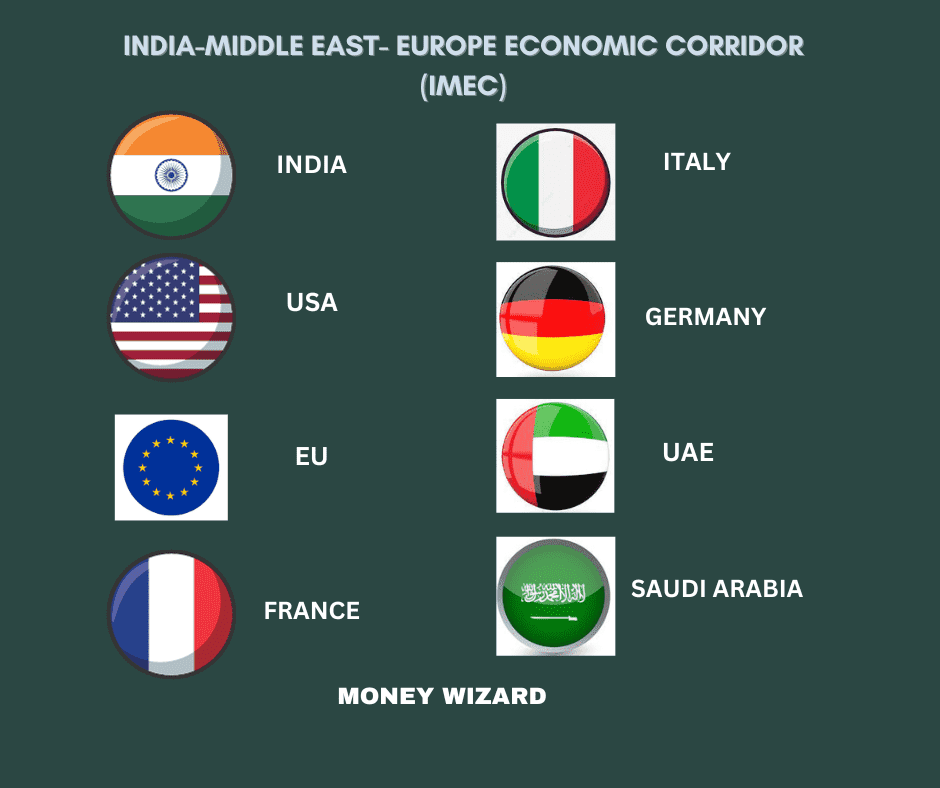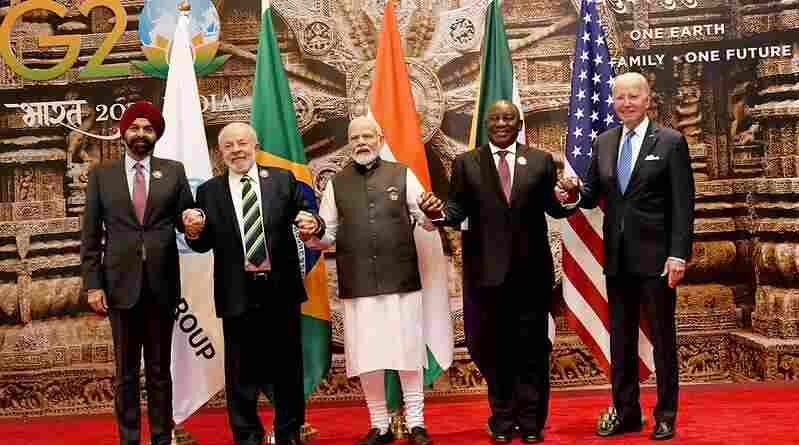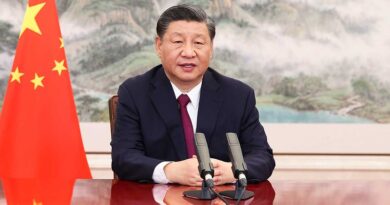The India-Middle East-Europe Economic Corridor (IMEC): A Strategic Counterbalance to China’s BRI?
Introduction
The Mega Economic Corridor connecting India with the Middle East and Europe, the India-Middle East- Europe Economic Corridor (IMEC), was officially launched on September 9, 2023, by Indian Prime Minister Narendra Modi. Countries including the USA, the European Union, France, Italy, Germany, the UAE, Saudi Arabia, and India came together to form a significant and historic collaboration.
When India’s National Security Adviser Ajit Doval met with his US colleague Jake Sullivan in May 2023, the issue of connectivity through sea and railway routes between India, the Arabian Peninsula, and Europe was discussed. Since then, the concept has gained popularity much more quickly than expected.
The Project would be a significant tool for economic integration between India, West Asia, and Europe in the future. The corridor would give a new direction to global connectivity and sustainable development.
What is the India-Middle East-Europe Economic Corridor Project?
India has signed a historic memorandum of understanding (MoU) to create an India-Middle East-Europe economic corridor with other G20 nations in an effort to boost economic development through improved connectivity and economic integration. The project will have two corridors: Eastern Corridor and Northern Corridor. The first link will connect India with Middle East, and the second corridor will link the Middle East with Europe.
This connectivity through rail and sea routes is seen as a part of the Partnership for Global Infrastructure Investment (PGII)- a joint G7 nations initiative to provide funding for infrastructure projects in countries with limited resources.
Member Nations

- India
- United States of America
- European Union
- France
- Italy
- Germany
- United Arab Emirates
- Saudi Arabia
Objectives of the Project
- To streamline the movement of goods by developing efficient transportation networks, including railways and ports.
- The project’s goal is to increase trade among the participating nations, especially trade in energy items.
- To promote closer economic ties and cooperation among member countries by reducing trade barriers and improving connectivity.
- By reducing transportation costs, the corridor can make goods more affordable for consumers and businesses. This can lead to increased economic efficiency and competitiveness.
- The corridor aims to incorporate environmentally sustainable practices and reduce the environmental impact of transportation and infrastructure development.
- It might also be one of the most ambitious responses to China’s huge infrastructure project, Belt and Road Initiatives, which aims to further integrate the global economy with that of that nation.
- Through a greater flow of energy and digital communications, it would promote prosperity among the participating nations.
- The project would address the issue of the absence of infrastructure in low- and middle-income nations, which is a barrier to growth.
India-Middle East-European Economic Corridor (IMEC) Vs China’s BRI
The G20 project will generate revenue and be bankable, in contrast to China’s BRI project, which has placed some of its host countries in a debt trap.
Concerns over the BRI’s ability to service its debt and the slowing Chinese economy have recently become more pressing issues. Concerns are being voiced about the BRI’s viability because of declining growth rates and rising debt levels. Italy, according to some reports. intends to withdraw from the BRI project,
According to NDTV’s interview with Railway Minister Ashwini Vaishnaw, the IMEC will be “substantially different” from the BRI. “In contrast to the Chinese BRI project, which has put some of its host countries in a debt trap, the G20 project will bring in financial resources and be bankable.” This corridor is crucial to the PM’s goal of bringing everyone along, he said in the interview.
According to Indian Cabinet minister Mr. Ashwini Vaishnaw “Several multilateral institutions are willing to fund the India-Middle East-Europe Economic Corridor (IMEC) project because the project will be so bankable,”
Does IMEC Represent India’s Counterweight To China’s BRI Project?
The India-Middle East European Economic Corridor (IMEC) is seen by many experts in Strategic Affairs as a counter to China’s Belt and Road Initiative (BRI) Project.
India has been a vocal opponent of China’s Belt and Road Initiative (BRI), primarily due to concerns related to sovereignty, territorial integrity, and strategic interests. The BRI is a massive infrastructure and economic development initiative led by China, aimed at enhancing connectivity and trade between China and countries across Asia, Europe, Africa, and beyond. Here are some of the key reasons why India has opposed the BRI:
Sovereignty and Territorial Disputes: One of the major concerns for India is that some components of the BRI, particularly the China-Pakistan Economic Corridor (CPEC), pass through Pakistan-occupied Kashmir (PoK), which India claims as its territory. India’s opposition to the BRI is partly driven by its objection to infrastructure development in areas that are subject to territorial disputes.
Strategic Concerns: India views the BRI as a strategic move by China to expand its influence in South Asia and the Indian Ocean region, which India considers its sphere of influence. The development of infrastructure and ports through the BRI could potentially have military implications in the event of a conflict.
Economic Imbalance: India has expressed concerns about trade imbalances with China and fears that the BRI could exacerbate these imbalances further. Indian policymakers have raised issues regarding unfair trade practices and non-tariff barriers that hinder Indian exports to China.
Lack of Transparency: India has criticized the lack of transparency and financial sustainability of BRI projects. There have been concerns that BRI loans to developing countries may lead to debt dependency and could compromise the sovereignty of these nations.
Environmental and Social Concerns: India has also raised concerns about the environmental and social impacts of some BRI projects. Large-scale infrastructure projects can have ecological and social consequences, and India has called for adherence to international environmental and social standards.
Alternative Initiatives: India has pursued its own regional connectivity initiatives, such as the International North-South Transport Corridor (INSTC), the Chabahar Port project in Iran, and various regional groupings like BIMSTEC (Bay of Bengal Initiative for Multi-Sectoral Technical and Economic Cooperation), to enhance regional connectivity and trade independently of the BRI.
Quad and Partnerships: India has strengthened its partnerships with like-minded countries, including the United States, Japan, and Australia, as part of the Quadrilateral Security Dialogue (Quad). The Quad aims to promote a free and open Indo-Pacific and is seen by some as a counterbalance to China’s expanding influence in the region.
The India-China Galwan Valley Conflict, also known as the 2020 Galwan Clash, was a significant border clash between Indian and Chinese forces in the Galwan Valley, a disputed region along the Line of Actual Control (LAC) in the Himalayas. The conflict occurred in June 2020 and resulted in fatalities on both sides.
The Galwan Valley clash had significant repercussions for India-China relations. It led to widespread public anger in India and calls for boycotts of Chinese products. Both countries increased their military infrastructure along the border, further intensifying the military standoff.
Relations between the two neighbors have gotten worse after the conflict in the Galwan Valley in 2020. India has been attempting to attract manufacturing industries away from China while also putting a number of limitations on Chinese businesses. In order to attract international businesses that are skeptical of geopolitical tensions between the US and China, the Indian government has developed a number of incentive programs.
According to a report submitted by the Center for Global Development, With promises to invest up to $8 trillion in infrastructure projects throughout Europe, Africa, and Asia, China’s Belt and Road Initiative raises serious questions about the sustainability of sovereign debt in the eight nations it funds
The report examined the 68 nations hosting BRI-funded projects’ present and prospective debt loads. In eight of the 23 nations that are now in danger of debt distress, it was discovered, future BRI-related finance will greatly increase that risk
The study further claims that China’s track record of managing debt distress has been problematic and that, unlike the other major government creditors in the world, China has not ratified any enforceable rules for avoiding unsustainable lending and dealing with debt issues as they materialize.
Challenges Ahead
The IMEC Corridor is a large-scale infrastructure initiative designed to connect many nations, foster economic development, and improve interregional cooperation. There are many challenges that may arise along this corridor:
- Developing transnational corridors is costly, and securing financing can be challenging. The countries involved may have differing financial capabilities, leading to disputes over funding and debt burdens.
- Large-scale infrastructure projects can have significant environmental consequences, including deforestation, habitat destruction, and increased pollution. Mitigating these impacts is crucial but often challenging.
- Once constructed, maintaining the infrastructure is essential for the corridor’s long-term success. Maintenance can be costly, and disputes over responsibility can arise.
- Different countries often have varying regulations and legal systems, which can complicate trade and investment along the corridor. Harmonizing these systems can be time-consuming and politically sensitive.



